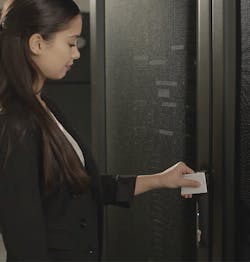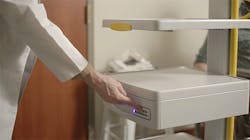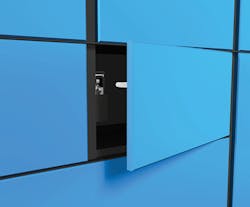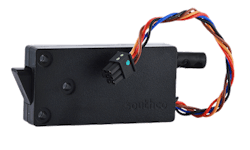This file type includes high resolution graphics and schematics when applicable.
The continuous introduction of new technologies and the growing Internet of Things (IoT) is creating new opportunities for electronic access to enclosures. Although controlling access to enclosures via traditional lock-and-key based devices is still common practice, incorporating electronic access control is still a relatively new concept for many designers and engineers.
As technology becomes more sophisticated, the variety and types of intelligence available in electronic-access devices can seem endless and overwhelming for engineers trying to determine which option is right for the task at hand. To understand which type of electronic access best suits their applications, engineers need to navigate a variety of locking and latching options with a broad range of functions and built-in intelligence.
Knowing how the enclosure will likely be accessed in a given application provides the best way for determining the most logical solution. Does the latch need to be unlocked automatically when a signal is sent? Will it need to stay open for a preset period of time before relocking? Understanding the application and level of control needed lets designers choose appropriate lock features and control requirements.
The Basics of Electronic Access
Intelligent electronic locks, when combined with appropriate user interfaces and access controls, offer an array of potential benefits—among them, enhanced security, improved industrial design, and convenience. Whether the goal is to control a centralized bank of lock boxes within a self-service parcel delivery locker, or to secure a government data cabinet or mobile pharmaceutical dispensing cart, intelligent locking and latching improves ease of use and security.
Electronic locking has evolved considerably since its inception. The most basic forms of electronic locks are simple electromagnets, or solenoids. When a user “unlocks” the lock, a current traveling through a coil of wire creates a magnetic field that attracts a metal plunger or locking pin. The locking pin moves into an unlocked position state against a spring. Once the current is switched off (that is, the lock is relocked), the magnetic field disappears and the spring pushes the pin back into the locked position.
These mechanisms work well, up to a point, but faces several limitations. For example, they typically require constant current to stay open, which does little to conserve energy. Second, they usually provide relatively little working force. Once locked, the closure is fairly strong, but the electromagnetic force is typically quite low during locking and unlocking. If any resistance to pin movement develops, such as a friction-producing misalignment caused by lock tolerances, panel warping, or pressure against the door from an overloaded compartment, the lock will fail. Lastly, solenoid locks have minimal intelligence beyond a simple on/off switch; there is no way to precisely control how or when the lock opens or close, or who has access to it.
Motor-Driven Locks
In contrast to solenoid-type locks, modern gear-motor drives requires less current to handle greater loads, making them a more efficient method of electrifying locks without increasing their size. Being able to handle greater working loads increases the lock’s reliability. For example, items inevitably get jammed into or become wedged inside lockers and drawers, pressing against the door from the inside. Unless the lock can operate against heavy mechanical loads, jams may lead to critical failures. Failures are unacceptable in applications such as remote equipment where maintenance may not be immediately available. High-quality, microprocessor-based, motor-driven locks can be precisely controlled and monitored for better performance and security.
Gear motor-driven locks can be managed by mechanical switches that direct the motor to either lock or unlock an enclosure, or through solid state microprocessor controlled sensors that add sophisticated levels of intelligent control. Some of these locks rely on external processing power, while others incorporate built-in electronic intelligence. In addition to lock control, integrated microprocessors let designers easily add extra features such as LED signaling or access control. Electronic intelligence within the locking device also makes it easier to integrate the lock with available control systems and accommodate a wide variety of access control inputs. Designers should specify gear-motor-driven locks that draw minimal current as this reduces overall cost and complexity.
Form Determines Function
Electronic locks and latches operate differently, and this partially dictates the benefits they can provide. With electronic locks, an electromechanical actuator prevents anyone from manually opening the lock until the actuator receives a signal from its associated access control device—an RFID (radio-frequency identification) reader, for instance. The actuator may be built into the lock or installed separately—perhaps retrofitted to control access to a pre-existing mechanical lock. Unlocking signals can also be sent from remote, networked computers, which is useful in applications such as data centers where the security administrator is not on-site.
Electronic locks can be programmed to re-lock after a designated time period regardless of whether the enclosure has been opened. This is useful when valuable items need to be re-secured, such as at medical clinics or jewelry stores where end users may unlock a cabinet and then become side-tracked by other job-related activities.
When considering budgetary constraints, the design of the electronic lock can significantly affect overall system cost. For example, a more efficient electronic lock with minimized current draw means less wiring and lower-cost solid-state controls.
Electronic latches are actuated similar to electronic locks. Each receives a signal from a remote control system and actuates the electromechanical device. Mechanically however, they differ. Electronic latches operate against the closure load, which may include a gasket and the weight of the drawer, as well as any “pre-load” from oversized items wedged into the compartment. Because of the constant closure load, electronic latches tend to require more power than electronic locks. It is particularly important that electronic latches operate reliably even against heavy mechanical loads—as it might be the case in a gasketed enclosure—to avoid failure.
Once the latch receives a valid signal, the gasket (or door pre-load) is released and forces the compartment open. After the door is opened, the user must manually push the door closed to re-lock it. Electronic latching solutions can be configured with timed re-lock features. In this case, it is common to include a door and lock sensor to ensure doors are re-closed and locked after remote access.
Electronic locks typically require less current to operate than electronic latching/unlatching devices. The primary reason for this is that end users provide the necessary energy to latch or unlatch the door.
Intelligent Actuation
In addition to actuation type (locks and latches), there are many other options available for electronic access devices. As explained earlier, timing control can mean specifying the timespan an electronic lock remains unlocked. But it can also be used in other ways, such as to delay opening or to automatically provide access only at particular times each day. Internal sensors can detect lock and/or door status for alarming and monitoring, or to alert users when equipment is accessible. For maximal efficiency, these locks are often programmed to enter sleep mode when idle.
Some intelligent locks and latches can regulate voltage, allowing them to operate consistently over a wide range of input voltages. Additionally, electrical overload protection can shield the system from power drops and surges, as well as overcurrents caused by system anomalies or user/installer errors.
Intelligent electronic locks and latches may also incorporate malfunction or tamper monitoring. If a basic electronic lock becomes jammed or the motor stalls, it may continue drawing current until the motor or other critical components fail. Intelligent locks and latches with self-diagnostics can protect against stalled motors. When there’s a mechanical blockage causing a power surge or malfunction, for instance, these systems can be programmed to sense the problem, power the device off and on, and then retry. If the problem persists, the device can be disabled and an error message sent to a local alarm or over a network to remotely monitor equipment status. This helps prevent damage to the electronics controlling the lock, ensuring it will still function as planned. Device-monitoring features can go a long way in safeguarding and maintaining equipment security.
Controls
Electronic locking systems offer various levels of intelligence to meet operating needs. For many applications, having all the relevant functions built into the latch/lock is the most sensible solution. Placing a rich set of smart electrical and mechanical features into the locking device adds a great deal of value in terms of efficiency, convenience, and utility, and may reduce the control’s cost and complexity.
Microprocessor-based controls expand the programing capability and customization of locking functions, such as unlocking time, input and output signal algorithms, and communication protocols with external systems. The electronic lock, a critical element of equipment access, provides all the feedback to the networked security system. This level of intelligence and networking is vital for remote equipment containing sensitive data or material that requires higher levels of access control.
Electronic locks and latches can be selected with varying degrees of intelligence, depending on the sophistication of the controls. Electronic access devices can then be simplified if the appropriate functions are provided by intelligent controls.
Additional Design Considerations
A wide variety of design variations in the electronic lock or latch’s physical characteristics can be chosen to suit specific applications. Selecting the appropriate housing material for instance, might affect reliability, depending on the operating environment. A corrosion-resistant plated-steel or stainless-steel outer body with a sealed internal actuator, for example, will help an electronic lock resist moisture and dust for dependable outdoor applications. Outdoor applications may also need actuators that withstand extreme temperatures. And although metal housings offer more durability, plastic may be suitable for lightweight applications.
Material may also determine if some features are available. For instance, built-in RFID readers or proximity switches for “door-open” signaling may not read when housed behind some metals. They may require nonconductive housings to prevent electromagnetic interference.
Installation factors should be taken into consideration. Will the lock be concealed or externally mounted? Wire routing and connector compatibility are also important elements to consider. Power consumption is another area of concern, including power supply, wiring, and electrical system specifications. Additionally, a lock may need a manual override for access in the event of a power loss.
When investing in any new technology, considering the track record of the device and suppliers is essential. Have they proven themselves over time? Does the supplier have a reputation as a market leader? Does the supplier partner with other proven solution providers? Depending on the application, global availability of components and technical assistance may come into play. Knowing as much as possible about potential vendors and the availability of their global support is always advisable.
What’s the Difference Between Electronic Latching and Locking?
Fundamentally, when an electronic latch is unlocked, the enclosure door pops open of its own accord. When an electronic lock is actuated the enclosure appears unchanged, but users can open it manually by turning a handle or sliding a bolt. One key consideration when deciding between a lock or latch: Will users benefit from the compartment opening upon actuation, or does the door need to remain closed until manually released?
A few illustrations should help explain the possibilities and ramifications of latching and locking. In a medical dispensing cart with several drawers holding different medications, an electronic latch and pop-open door are convenient and save time. On the other hand, it’s best not to advertise that a server cabinet in a communal data storage facility is unlocked and open. In such cases, electronic locks are more appropriate. Parcel pickup lockers may be easier and more convenient if the door swings open when the latch is activated. In contrast, remotely actuated baggage doors on an RV are best left closed until the RV owner/user is ready to access them.
This file type includes high resolution graphics and schematics when applicable.







